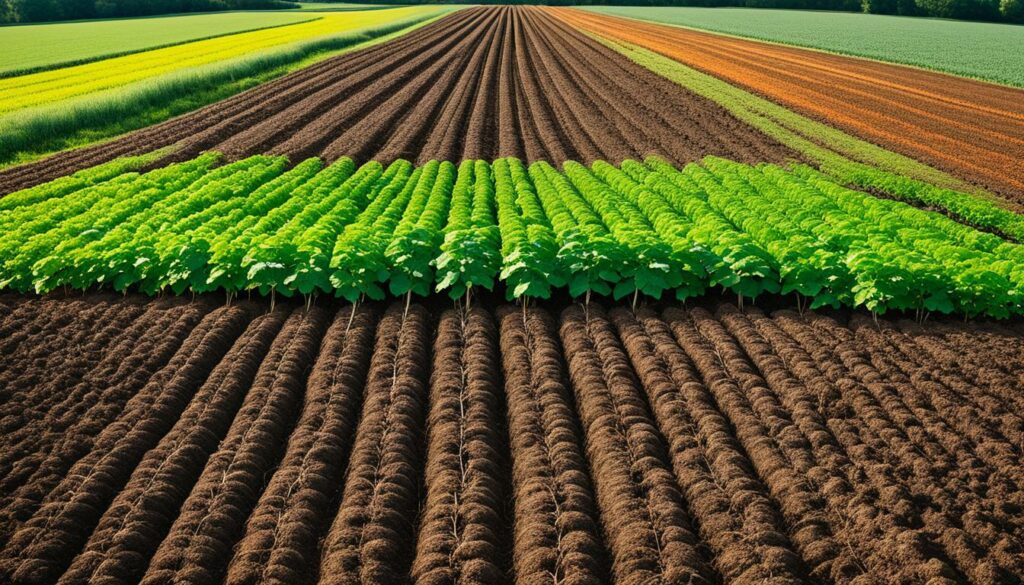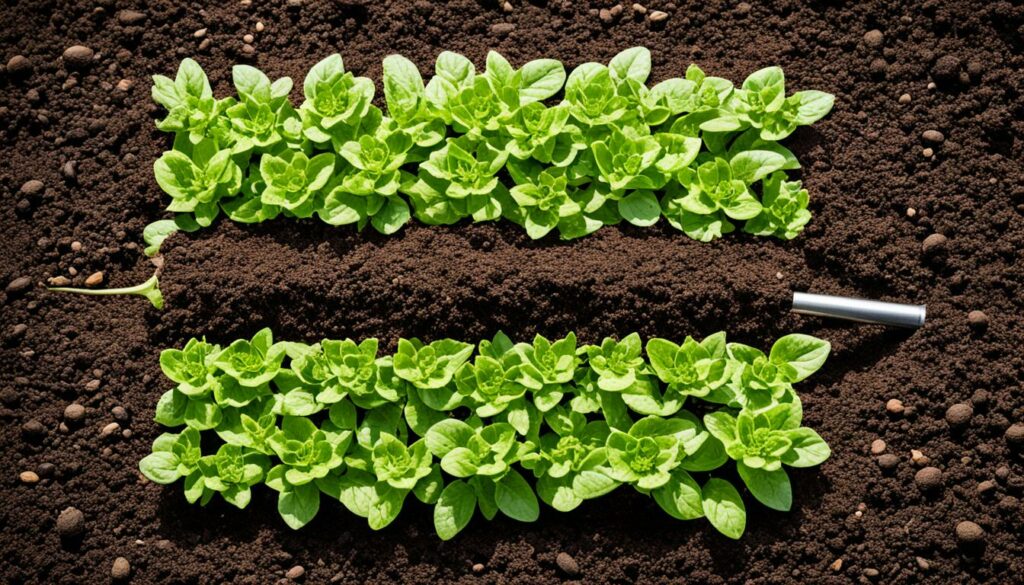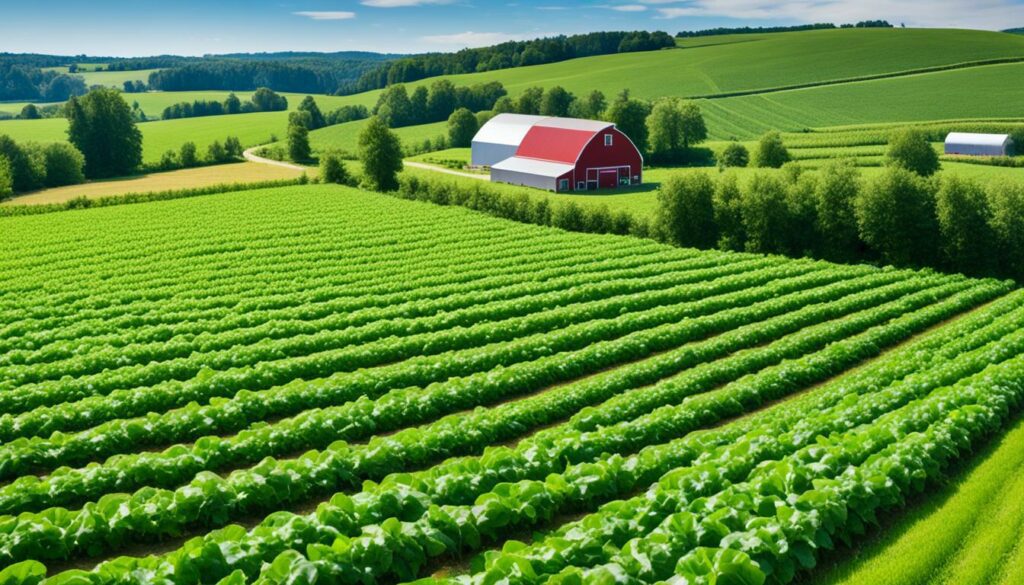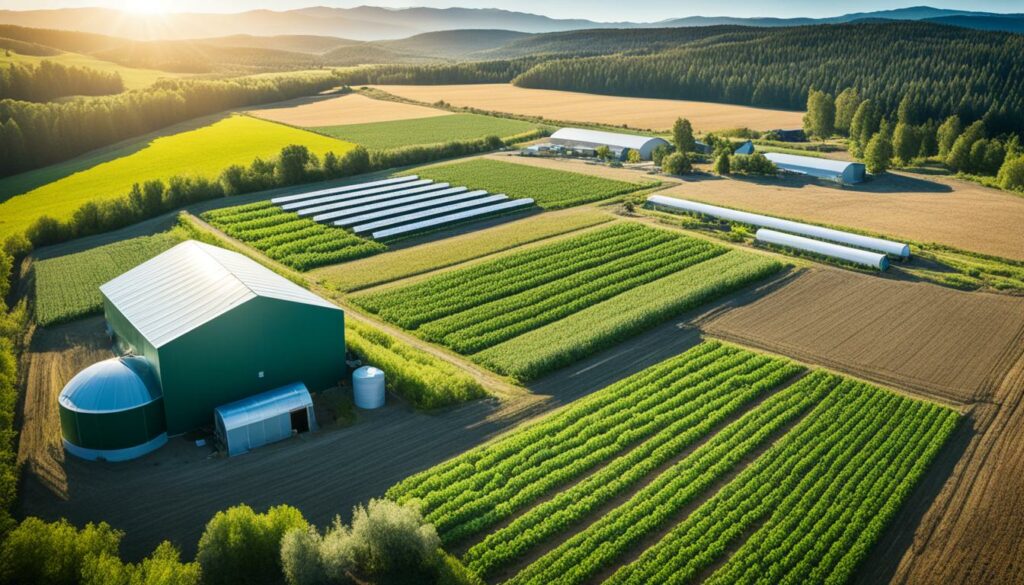Menu

NatWest and WWF are working together to give British agriculture a big boost. Their £6.7 billion commitment is huge news. It means the farming sector is moving towards practices that heal the planet. This change is vital in the fight against climate change and the protection of our wildlife.
Regenerative agriculture is changing the game in tackling climate change. It aims to take in carbon dioxide from the air through natural ways. This encourages more wildlife to come back and better care for farm animals. The result is healthier food and farms that can cope with harsh weather. A group called Regenerative Food and Farming is making people aware of this urgent need for change. They are teaching about farming in ways that help nature, produce food locally, and restore the environment.
Regenerative agriculture isn’t just a new idea. It takes wisdom from ancient times and combines it with today’s knowledge. It’s a farming method that looks to the past for guidance.
This type of farming learns from history, like the green revolution and the rise of organic farming. It also values the knowledge of indigenous people and local farming groups. The goal is to mix the best ideas from old and new farming.
There are different levels of regenerative agriculture, depending on how well it’s used:
The UK is losing its natural plants and animals fast, more than half in fifty years. The number of birds on farms has also dropped by over 50%. The UK government wants to change this, setting goals to better care for land by 2028. Using regenerative farming can also help cut harmful gases by a lot.
| Level | Focus Areas | Outcomes |
|---|---|---|
| Functional (Level 1) | Soil health repair, reducing greenhouse gases | Improved soil structure, lower emissions |
| Integrative (Level 2) | Regenerating biodiversity, whole ecosystems | Enhanced biodiversity conservation, ecosystem resilience |
| Systemic (Level 3) | Viewing farms as interconnected ecosystems, systems thinking | Holistic management, broader ecological understanding |
| Evolutionary (Level 4) | Deep ecological understanding, multi-generational stewardship | Sustainable practices rooted in cultural heritage |
Regenerative agriculture is more than farming; it’s a way to fight climate change. It’s about farming in a way that helps the planet heal. It offers hope for the future of our food and the environment.
Regenerative farming helps the environment and boosts farming. It focuses on keeping soil healthy, captures carbon, and increases plant and animal life. This way, it helps farming to last in a sustainable way.
Keeping soil healthy is key in regenerative farming. It makes land more fertile by adding organic matter, and lowers the risk of soil problems like compaction or erosion. This is crucial because farming is a big part of the UK’s greenhouse gas emissions.
High-tech tools, like sensors and apps, help farmers this. They ensure the hard work in keeping the soil healthy pays off.
Regenerative farming fights climate change by storing carbon in the soil. This cuts the UK’s greenhouse gas emissions by a big amount. It could be like taking 900,000 cars off the road. The goal is for UK farming to have zero net emissions by 2040.

Regenerative farming also boosts plant and animal diversity. This supports the environment to bounce back and stay strong. Teaching farmers to grow a variety of crops and plant trees helps. It’s helped places like Kenya and Zimbabwe create stronger local economies.
Transitioning to regenerative agriculture in the UK faces many hurdles. These challenges slow down how quickly and how well these eco-friendly practices are used. Farmers have to tackle issues that need both money and new knowledge to fix.
The biggest issue is the cost. Moving to regenerative methods means spending more on seeds, tools, and farming land. But there’s no guarantee these changes will make a profit.
Another problem is the shrinking number of farmland birds, dropping by over 50% in fifty years. The UK’s natural variety is also at risk, with just over half of its biodiversity remaining. These facts show the pressure to adopt new, sustainable ways of farming.
Understanding regenerative farming is not easy because there’s a lot we don’t know. We often don’t have clear definitions or solid facts on what works. This situation makes it tricky to put good practices to use, and it can lead to pretending to be eco-friendly.
Yet, it’s vital to fight for farming that’s ready for climate change. Events like the Groundswell Festival are making a big difference by educating thousands of people. To reach the government’s target for sustainable soil management, we need a big push in different areas.
The UK government values farming policies that are good for the environment. These help farmers deal with issues like supply disruptions and low prices. They are keen on the Sustainable Farming Incentive. It’s a scheme to make farming more eco-friendly. Farmers are encouraged to use methods that capture carbon and are good for the environment.

The Sustainable Farming Incentive (SFI) is part of the government’s big plan for farms. It makes sure farmers look after their soil well. Good soil health is key for wildlife and efficient farms. The aim is to have 40% of farmland well-managed by 2028, rising to 60% by 2030. This will cut soil damage, increase organic matter, and make soil better overall.
The government aims to make farming almost climate-neutral by 2050. This means using policies that capture carbon in the soil. By doing this, the sector could cut greenhouse gases by 66% to 77%. Important steps include better data for farmers and rules for new carbon markets. Meanwhile, NatWest is leading with £6.7 billion to help farms go green. This shows that reaching green goals needs everyone in the food business to work together.
The private sector is key in boosting regenerative agriculture UK. It helps in making big changes with its private sector support. Leading financial firms such as NatWest have started giving out big funds. This money is pushing farmers to use more eco-friendly farming methods.
UK’s Government and WWF-UK are working together on a big plan. It covers help all along the farming chain to make sure regenerative farming works well. This plan also talks about how private money can help the environment.
Lately, financial groups have been making offers that help farmers who want to try regenerative agriculture UK. This is important because it guides farming towards positive impacts on nature. The UK is aiming for big private investments in nature recovery soon. It plans to hit £500 million per year by 2027 and over £1 billion per year by 2030.
A scheme called NEIRF is really making a difference. It gives out grants up to £100,000. This scheme has helped 86 projects in England get ready for investments. For example, the Hadrian Bond project is looking to grow. It focuses on making farming land better, covering 10,000 hectares in three areas. It shows how much the private sector is getting involved.
Recent surveys show people really want to see changes in how we make food. This matches what regenerative agriculture UK aims for.
The UK government wants to open up new nature-friendly markets. They’re doing this by making tools like the Farming Toolkit for Accessing Nature Market Opportunities. In addition, groups like Projects for Nature are helping connect businesses that want to support projects that help nature. Lloyds Banking Group, for instance, offered £250,000 to nature projects.
The private sector is also working hard to build trust with farmers. For example, they’re working closely with the British Standards Institution. These efforts are making the move to eco-friendlier farming in the UK happen faster.
Case studies show that regenerative farming brings big wins for nature and money. These stories highlight real results from saving plants and using smart farming methods.
Laureano is a farmer who’s seen big changes by using regenerative methods. His maize harvest has gone up three times for each plant. This jump has made his family self-sufficient in food. They can now afford education and healthcare. No more day jobs for him. Green manure and cover crops help him produce more than enough nitrogen for his crops. He makes about 60 tons of organic matter per hectare every year. This boosts his farm’s health a lot.
Durie Farms in Fife is a top example of big regenerative farming. Covering 570 hectares, one-third has been organic since 2006. The rest follows innovative Conservation/Regenerative Agriculture methods. Some fields haven’t been ploughed since 1999. They’re direct drilled and heavily cover cropped. Beans, linseed, peas, and spring OSR are planted to keep the soil and pests in check. Plus, some small spots grow trees, adding more wildlife space.

| Farm | Location | Size (hectares) | Notable Practices | Results |
|---|---|---|---|---|
| Durie Farms | Fife, Scotland | 570 | Organic conversion, cover cropping, diverse species break crops, tree planting | Top 10% in financial health, enhanced soil structure, reduced pest concentration |
| Laureano’s Farm | Mali | Smallholder | Green manure, cover crops, crop rotation | Tripled maize harvest, self-sufficiency, improved family welfare |
These examples prove that regenerative farming works both on small and large scales. They show how saving nature and clever farming can build strong, lasting farms. Looking at both little and big farms, we learn that regenerative agriculture can be adapted widely. Its benefits are great all around.
Using new farming methods helps keep the soil healthy. It’s key for eco-friendlier farming. Jo Franklin’s work, inspired by a Nuffield Scholarship in 2010, focuses on these new approaches. She notes a big drop in the UK’s soil organic matter, which hurts soil health.
One solution comes from companies like Yara. They make fertilisers that use organic materials. These help improve both soil and crop health. Natalie Wood explains that adding organic stuff to soil is vital. It keeps it healthy and full of nutrients. This way, the fertilisers help the environment by cutting waste and pollution.
James Price and others are happy with the results of these fertilisers. They’re into using new products. Jo Franklin and James Price also do simple things like adding straw and manure. They grow cover crops and change what they plant. Cover crops are amazingly good for soil health. They keep the soil alive, stop water from leaving, and keep important nutrients in the ground.
High-tech tools are also making a difference. The Soil Health Scorecard (SHSC) is one such tool. ABACO Group and NIAB made it to check on soil health and how land is performing. Big stores like ASDA, Tesco, and McCain are into it too. This tool looks at soil samples and gives advice. It helps farmers do their work better.
These methods are not just for now but for the future too. McCain aims to be fully eco-friendly in its potato farming by 2030. The SHSC app is a big part of making this happen. It uses smart technology to improve farming and deal with food problems. It’s all about doing farming in a way that lasts for years.
People like Elizabeth Stockdale and Natalie Smith are all for these new tools. They talk about how important it is to protect the soil for coming generations. And how soil helps make nature strong and keeps us safe from disasters. Chris Brown from ASDA says the Scorecard is a great tool. It brings everyone together to do farming in a way that doesn’t harm the planet.
| Technique | Benefits |
|---|---|
| No-till Farming | Reduces soil erosion, increases water infiltration, and promotes biodiversity. |
| Cover Cropping | Maintains soil structure, retains moisture, and captures nutrients. |
| Crop Rotation | Prevents pest cycles, enhances soil nutrient profiles, and improves yield stability. |
| Organic-based Fertilisers | Boosts soil organic matter, improves nutrient availability, and reduces carbon footprint. |
Ecological farming techniques are key in regenerative agriculture. They mix old ways with new ideas to boost farm yield and help the environment. In the UK, about 70% of farm land is for permanent pasture. So, using sustainable farming practices is really important. Sadly, just one type of grass is often grown, which harms soils and causes floods, especially in wet, hilly places.

Regenerative farming principles are needed to fight these problems. This includes not disturbing the soil much, keeping it covered, having plants in it all the time, and growing many types of crops. Adding animals that graze fits in as well. By acting like we’re always growing grass, even with yearly crops, we can protect and improve soils.
The way rain, sun, and frost touch the soil shows why it needs to be covered. Plants or leftover bits from crops can do this job. These ecological farming techniques keep the soil healthy, helping it last a long time and bounce back from tough times.
Recently, over 100 farming experts got together for a CHAP webinar on regenerative methods. This shows lots of people care about these ways. Using sustainable farming practices unites whole communities with the same goals. It helps make farming sturdy and the land strong.
CHAP works hard for soil health. They check farming methods and study how much carbon can be kept in the soil. Following regenerative rules and using ecological farming techniques could lead the UK to a better farming future. This could benefit both the economy and society a lot.
Climate change is a big issue for UK farms. It makes them need to use adaptive farming practices. These are to make sure farms can cope with changes. The weather’s changing and extreme events happen more often. This shows how important it is to farm in ways that can handle climate changes.
In the UK, we’re losing too many of our plants and animals. Only 50.3% of our natural variety remains, way less than the world average. Soil issues are putting nearly 4 million hectares at risk. To tackle this, England has started a programme to improve soil health. The goal is to manage 40% of English farming soil sustainably by 2028. This should increase to 60% by 2030.
According to the Food, Farming, and Countryside Commission, regenerative agriculture in the UK can cut greenhouse gas emissions by a lot. From 66% to 77% to be exact. The government is offering money to farmers who help by farming in ways that are good for the environment. They give £55 per hectare for certain planting and £45 per hectare for avoiding insecticides.
The festival called Groundswell for Regenerative Farming is getting more popular. In it, people learn about and celebrate farming that’s good for the earth. Since 2016, the number of people going has grown a lot, from 450 to 5,500 in 2022. But, switching to full-scale regenerative farming can cut how much crops we get from each field by 27%. This way of farming needs a lot of work on the soil before planting, and it’s hard for some farmers to afford. Plus, there’s confusion about what exactly “regenerative farming” means.
To really make a change, everyone needs to pitch in. That includes the government, companies that sell the food, all of us who eat it, and ongoing research. We all need to work together. This is the way to make sure farming can deal with climate change and still be successful.
Organic farming fits well with the idea of sustainable living. It focuses on using fewer chemicals and helping nature thrive. It’s known for making soil better and for increasing the number of plants and animals. But it’s key to see how it’s different from another method called regenerative farming.
Both organic and regenerative farming aim to be better for the planet. But they focus on slightly different things. Organic farming doesn’t allow synthetic chemicals or genetically modified organisms. It takes care of pests and nutrients the natural way, which creates a healthier environment.
Regenerative farming goes further. It works on making the land even better than it was. It boosts the growth of the top layer of soil, improves how water moves, and captures carbon from the air. In short, regenerative farming looks at the whole picture of bringing nature back.

Using both organic and regenerative ways has a big plus. By mixing these approaches, we can trap more carbon, helping fight climate change. This could lower harmful gas emissions by a large amount. It also helps more plants and animals thrive, which is a key global issue.
What’s more, the UK’s government is offering money for these approaches. For example, they give £55 per hectare when a special plant is grown alongside the main crop. They also give £45 per hectare if no chemical pest killers are used. Farming this way not only improves the soil but also adds to a national effort. The UK wants 60% of farm soil to be managed sustainably by 2030.
Community projects play a vital role in spreading the word about regenerative farming. They get local people involved in making farming more sustainable. These projects help everyone feel part of a team working towards common goals.
The Groundswell Regenerative Farming Festival is a top event. It informs and motivates both farmers and the public about regenerative farming. At the festival, experts and fans of farming come together to learn and share. This strengthens regenerative farming efforts.
The Wendling Beck Environment Project in Norfolk is another standout. It brings together groups like the Norfolk Wildlife Trust and Norfolk County Council. This project tackles local environmental issues, such as water scarcity. It does this through things like restoring wetlands and promoting regenerative farming on its 2,000-acre site.
The project also works to create new homes for wildlife and beautiful grasslands. This effort supports not just *biodiversity* but local economies too, through activities like ecotourism. Their work shows how local people can really make a difference in regenerative farming.
From November 2023, UK planning will require Biodiversity Net Gain in new projects. This rule asks for at least a 10% boost in any habitats affected. It’s a push to do better for nature and include more people in caring for the environment.
These community schemes are key in driving regenerative agriculture forward. They encourage widespread support and ensure a stronger, more sustainable future for farming in the UK.
The future of farming in the UK is exciting. It’s moving towards being both more sustainable and resilient. While shifting to regenerative agriculture faces some hurdles, it offers many long-term pluses.

Dung beetles play a key part in this new farming way. They help the land by adding nutrients and improving soil health. This is important because intensive farming has made the soil less productive. Going regenerative helps the soil get better over the years.
This new way of farming has a lot of benefits. It means better crops, healthier soil, and more local wildlife. Plus, it saves money on things like fertilisers and fuel, making it a smart choice for the planet. A case study showed that, even though it earned less money at first, it became more profitable than traditional farming after a few years.
It’s important to remember that regenerative farming takes time to show its full benefits. A report from the summer of 2023 shows that big, fast changes are needed in the UK’s food and farm industry. It suggests that using regenerative farming methods is key to making this happen.
The report also says that everyone needs to work together. Both the government and businesses should join hands to support farming communities. Together, they can help tackle big issues like climate change and improving food for everyone.
| Metric | Conventional Farming | Regenerative Farming |
|---|---|---|
| Cereal Yield | 100% | 73% |
| Net Margin (Year 1) | 100% | 59% |
| Net Margin (Year 6) | 100% | 118% |
| Variable Costs Reduction | – | 10%-26% |
| Pest Burden | High | Reduced |
| Soil Health | Decreasing | Improving |
In the UK, regenerative agriculture is making big waves in the fight against climate change. It does this by improving the environment in several key ways. For example, it boosts the number of plants and animals living in an area. It also makes the soil healthier. Plus, it fights climate change by removing carbon from the air. And, it makes nature more able to bounce back from harm.
However, these changes are not easy. Farmers need to think in new ways and understand more about nature. They have to see farming as a part of the natural world around them.
Many farm owners in the UK are starting to use these new methods. This is good because it shows that these changes work. In America, farms using these methods made more money and used fewer resources. They proved that this new approach can be good for both the planet and their wallets.
One big way forward is for everyone to support local farmers. Local food is essential in the fight for a better environment. The food industry is always getting better, with new ways to farm that help our planet. By doing this, the UK can have farms that are stronger and full of life. With everyone’s help, the future of farming in the UK can be bright and green. It will take hard work from many, but the goal is within reach.
Regenerative agriculture in the UK is a big change to how farming works. It fights climate change by pulling carbon out of the air naturally. This happens through farming methods that are kind to nature, help wildlife, and make the land and soil stronger.
It uses farming ways that don’t harm the environment. By doing this, it brings back more plants and animals, making the land strong against climate change.
Farming like this makes the soil better, stops it from packing too hard, and stays in place. It also traps carbon, helping fight climate change, and makes sure many different plants and animals can live together.
Switching to these ways of farming can cost a lot more. Farmers worry if they’ll make enough money back because they have to spend more on things like land and supplies without seeing an immediate return.
The UK government is helping by offering rewards to farmers who take care of the soil well. They’re doing this to meet their goal of producing less pollution by 2050 and making sure more plants and animals can find a home in the countryside.
Companies are putting money into these new farming methods, working together with others in the food business. For example, NatWest is offering money to help, showing that everyone working together can create food that’s good for the earth.
There are many farms in the UK doing very well with regenerative farming, from the small to the very big. Seeing their success shows the real benefit of taking care of the land this way.
New ways to look after the soil include not turning it over, planting different crops in turns, and growing cover crops. These methods protect the soil, make more room for different plants and animals, and keep the whole system healthy without spending too much.
These techniques use nature to grow food without damaging it. They work with the land, making sure it continues to give us food while keeping the environment healthy.
Climate change makes it hard for farms as the weather becomes less certain. Regenerative farming is a way to deal with this, making farms stronger and more able to handle the changes.
Both want to use fewer chemicals and be good for the earth, but regenerative farming goes further. It wants to make the land better over time, combining the best of both to fight climate change and help nature.
Communities are key in spreading the word about this new way of farming. They help people learn and try new things by holding events like the Groundswell Festival.
This way of farming is key for the UK’s future, being good for both nature and food. It needs everyone to work together, doing their part. This includes support from the government, private companies, and a willingness from farmers, food makers, and people who eat the food to change for the better.